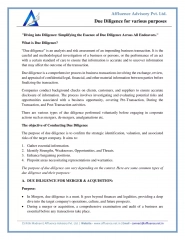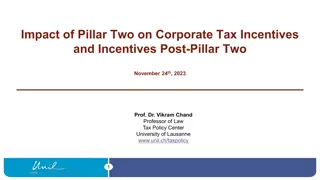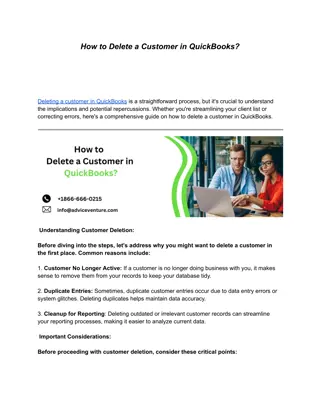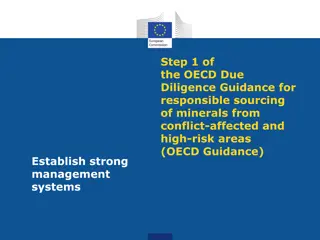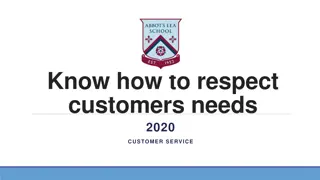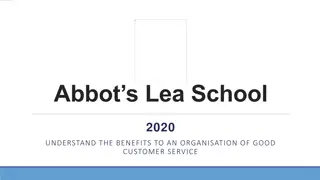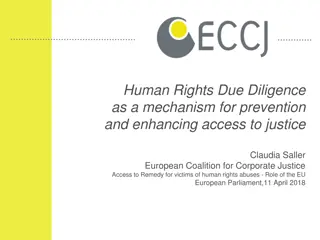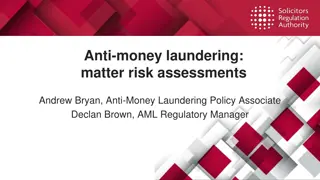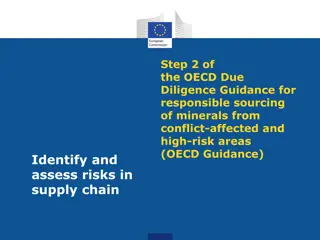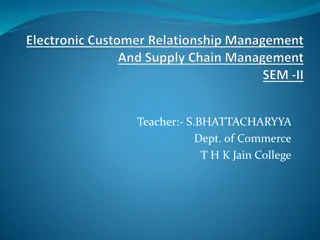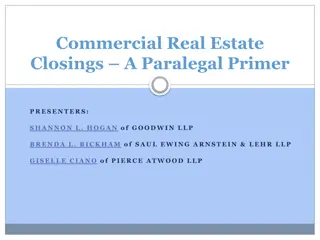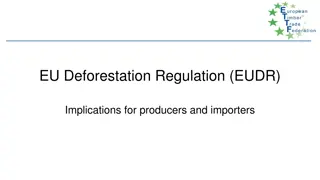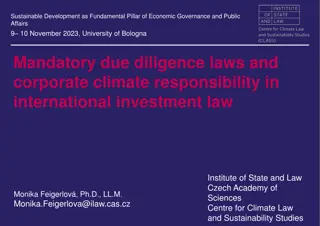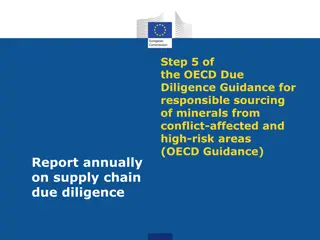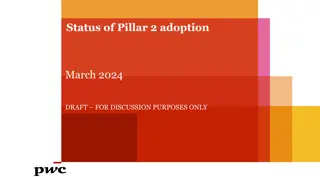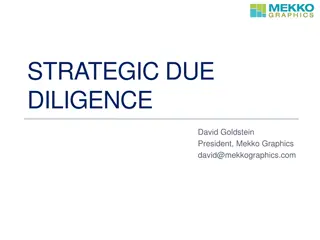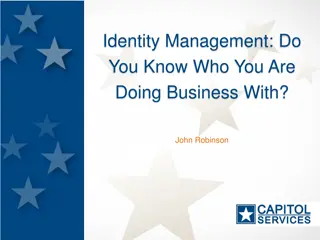Understanding the New Fifth Pillar of Customer Due Diligence
The Customer Due Diligence (CDD) Final Rule, effective from May 11, 2018, adds a crucial 5th pillar to Anti-Money Laundering (AML) Program requirements aimed at improving financial transparency and mitigating risks related to illicit transactions. The rule outlines key elements such as customer identification, beneficial ownership verification, and understanding customer relationships. By enhancing CDD practices, financial institutions can better combat money laundering, promote national security interests, and facilitate tax compliance.
Download Presentation

Please find below an Image/Link to download the presentation.
The content on the website is provided AS IS for your information and personal use only. It may not be sold, licensed, or shared on other websites without obtaining consent from the author. Download presentation by click this link. If you encounter any issues during the download, it is possible that the publisher has removed the file from their server.
E N D
Presentation Transcript
New Fifth Pillar: Customer Due Diligence (Beneficial Ownership) May 10, 2018
2 I. History, Purpose and Overview
New Fifth Pillar: Customer Due Diligence 3 In 2016, FinCEN issued the Customer Due Diligence (CDD) Final Rule The Rule adds a 5th pillar to Anti-Money Laundering (AML) Program requirements: the CDD pillar The Rule becomes effective May 11, 2018 Internal Controls Designate Chief EFCC Executive New Fifth Pillar Independent Training & Awareness Testing
Purpose 4 The CDD Rule is intended to help Financial Institutions avoid illicit transactions by improving understanding of the potential risks each customer presents. According to FinCEN, clarifying and enhancing CDD requirements will advance the purposes of the BSA in six ways: 1. 2. 3. 4. 5. 6. Assisting investigations by law enforcement; Advancing counter-terrorism and broader national security interests; Improving a financial institution s ability to assess and mitigate risk; Facilitating tax compliance; Promoting clear and consistent expectations and practices; and Advancing the Department of the Treasury s broad strategy to enhance financial transparency of legal entities.
The Path Towards a Final CDD Rule 5 CDD principles for Private Banking were outlined in Section 312 of the USA PATRIOT Act 2001 Interagency Guidance compilation of regulations, rulings and guidance covering CIP, private banking and correspondent banking 2010 FinCEN Advanced Notice of Proposed Rulemaking 2012 FinCEN invited private sector to weigh in on definitions, current practices, verification and challenges associated with certain products, services and relationships 2012 FinCEN Notice of Proposed Rulemaking addressed regulatory flexibility analysis , designed to examine the cost-benefit 2014 Public comment commenced 2014 FinCEN published a Regulatory Impact Assessment and Initial Regulatory Flexibility Analysis with a request for comment 2015 Final CDD rule published with final effective date of May 11, 2018 2016
4 Key Elements of Customer Due Diligence 6 I. Customer Identification and Verification Current CIP NEW! 31 CFR 1010.230 II. Beneficial ownership identification and verification Appropriate risk-based procedures for conducting ongoing customer due diligence, to include, but not be limited to: Amends BSA to add 5thPillar but viewed as restating existing expectations [31 CFR 1020.210] III. Understanding the nature and purpose of customer relationships to develop a customer risk profile; and IV. Conducting ongoing monitoring to identify and report suspicious transactions and, on a risk-basis, to maintain and update customer information
Overview of Beneficial Ownership Requirement 7 Must identify and verify the identity of beneficial owners of all legal entity customers (other than those excluded) for each new account at the time a new account is opened (other than accounts that are exempted) Beneficial Ownership has two mutually exclusive prongs: control and ownership Compliance is achieved by obtaining certification in the form of FinCen Appendix A or the equivalent information with certification of the accuracy of the information May rely on beneficial ownership supplied by the customer, provided Financial Institution has no knowledge of facts that would reasonably call into question the reliability of the information Verification of identity of the beneficial owners should contain the elements required for verification under CIP, but FIs may rely on copies of IDs provided by the person opening the account Updates to beneficial ownership should be event-driven as part of normal monitoring, not as a categorical requirement on a continuous or periodic basis. Applies to all legal entity customers, including existing customers.
8 II. Scope: What is a Legal Entity Customer
What is Legal Entity Customer? 9 Corporation Limited Liability Company Similar entity created by the filing of a public document with a Secretary of State or similar office, or formed under the laws of a foreign jurisdiction This includes limited partnerships, business trusts created by a filing with a state office, and general partnerships
Exempt Legal Entity Customers: 10 A FI regulated by a federal functional regulator or a bank regulated by a State bank regulator; A person described in 31 CFR 1020.315(b)(2) through (5); An issuer of a class of securities registered under section 12 of the Securities Exchange Act of 1934 or that is required to file reports under section 15(d) of that Act; An investment company, as defined in section 3 of the Investment Company Act of 1940, that is registered with the Securities and Exchange Commission under that Act; An investment adviser, as defined in section 202(a) (11) of the Investment Advisers Act of 1940, that is registered with the Securities and Exchange Commission under that Act; An exchange or clearing agency, as defined in section 3 of the Securities Exchange Act of 1934, that is registered under section 6 or 17A of that Act; Any other entity registered with the Securities and Exchange Commission under the Securities Exchange Act of 1934; A registered entity, commodity pool operator, commodity trading advisor, retail foreign exchange dealer, swap dealer, or major swap participant, each as defined in section 1a of the Commodity Exchange Act, that is registered with the Commodity Futures Trading Commission; A public accounting firm registered under section 102 of the Sarbanes-Oxley Act; A bank holding company, as defined in section 2 of the Bank Holding Company Act of 1956 (12 U.S.C. 1841) or savings and loan holding company, as defined in section 10(n) of the Home Owners' Loan Act (12 U.S.C 1467a(n)); A pooled investment vehicle that is operated or advised by a FI excluded under paragraph (e)(2) of this section; An insurance company that is regulated by a State; and A financial market utility designated by the Financial Stability Oversight Council under Title VIII of the Dodd-Frank Wall Street Reform and Consumer Protection Act of 2010. A foreign FI established in a jurisdiction where the regulator of such institution maintains beneficial ownership information regarding such institution; A non-U.S. governmental department, agency or political subdivision that engages only in governmental rather than commercial activities; and Any legal entity only to the extent that it opens a private banking account subject to 31 CFR 1010.620. Trusts; however, statutory trusts created by filing with the Secretary of State, or similar office, do fall under the definition of a legal entity customer, and thus the CDD Rule applies.
Entities Excluded from Ownership Prong 11 A pooled investment vehicle that is operated or advised by a FI that is not excluded from the definition of legal entity customer. Any legal entity that is established as a nonprofit corporation and has filed its organizational documents with the appropriate State authority as necessary. Such entities include charitable, nonprofit, not-for- profit, nonstock, public benefit or similar corporations.
FinCen FAQ Question 24: Definition of Legal Entity Customer: Publicly Traded Companies and Entities Listed on Foreign Exchange 12 Q. Are companies publicly traded in the United States and entities listed on foreign exchanges excluded from the definition of legal entity customer and, therefore, excluded by the Rule? A. Companies traded publicly in the United States are excluded from the definition of legal entity customer. Specifically, the Rule excludes from the definition of legal entity customer certain entities that are considered exempt persons under 31 CFR 1020.315(b). This includes any company (other than a bank) whose common stock or analogous equity interests are listed on the New York Stock Exchange, the American Stock Exchange (currently known as NYSE American), or NASDAQ stock exchange. The Rule also excludes a U.S. entity when at least 51 percent of its common stock or analogous equity interest is held by a listed entity. These U.S. companies are excluded from the Rule because they are subject to public disclosure and reporting requirements that provide information similar to what would otherwise be collected under the Rule. Companies listed on foreign exchanges are not excluded from the definition of legal entity customer. Such companies may not be subject to the same or similar public disclosure and reporting requirements as companies publicly traded in the United States and, therefore, collecting beneficial ownership information for them is required.
FinCen FAQ Question 25: Collection of beneficial ownership information: Legal entities listed on foreign exchanges 13 Q. May covered financial institutions take a risk-based approach for collecting beneficial ownership information from legal entity customers listed on foreign exchanges? A. No. Financial institutions may not take a risk-based approach to collecting the required beneficial ownership information from legal entity customers that are listed on foreign exchanges, because such institutions are not excluded from the definition of legal entity customer. However, as they may with regard to other legal entity customers, whether listed or not, covered institutions may rely on the public disclosures of such entities, absent any reason to believe such information is inaccurate or not up-to-date.
FinCen FAQ Question 26: Foreign FI 14 Question 26: Foreign financial institutions. Does the exclusion for foreign financial institutions from the Rule s definition of legal entity customer depend on whether the beneficial ownership requirements applied by such institution s foreign regulator match U.S. requirements? A. No. For purposes of beneficial ownership identification, the Rule excludes from the definition of legal entity customer a foreign financial institution created in a non-U.S. jurisdiction when the foreign regulator for that financial institution collects and maintains information on the beneficial owner(s) of the regulated institution. The rule does not require covered financial institutions to research the specific transparency requirements imposed on a foreign financial institution by its regulator and compare them with those imposed on U.S. financial institutions by U.S. Federal functional regulators. However, if the foreign regulator does not collect and maintain beneficial ownership information on the foreign financial institution it regulates, then U.S. financial institutions will have to collect and maintain beneficial ownership information on accounts opened by foreign financial institutions in compliance with the Rule. As with any exclusion, covered financial institutions may rely on the representations of its legal entity customer as to whether an exclusion applies, provided that they have no knowledge of facts that would reasonably call into question the reliability of such representation. (See Question 21.) For purposes of existing customer due diligence requirements, covered financial institutions that maintain correspondent accounts for foreign financial institutions are already required to establish and maintain specific risk-based due diligence procedures and controls for such accounts that include consideration of all relevant factors, and are required to identify beneficial ownership for certain high-risk foreign banks. These correspondent accounts will continue to be subject to these existing requirements rather than the requirements set forth in the AML Program requirements contained in the Rule.
FinCen FAQ Question 18: Beneficial Ownership Information: Pooled Investment Vehicles... 15 Question 18: Collection of beneficial ownership information: Pooled Investment Vehicles whose operators or advisers are not excluded from the definition of legal entity customer Q. Are covered financial institutions required to identify and verify the identity of the beneficial owners that own 25 percent or more of the ownership interests of a pooled investment vehicle whose operators or advisers are not excluded from the definition of legal entity customer? A. No. Although the Rule requires covered financial institutions to collect and verify the identity of beneficial owners who own 25 percent or more of the equity interests of a legal entity customer, in general, institutions are not required to look through a pooled investment vehicle to identify and verify the identity of any individuals who own 25 percent or more of its equity interests. Because of the way in which ownership of a pooled investment vehicle fluctuates, it would be impractical for covered financial institutions to collect and verify ownership identity for this type of entity. Therefore, there is no requirement that the financial institution should request the customer to look through the pooled investment vehicle to determine and report any individual s equity interest. However, covered financial institutions must collect beneficial ownership information for the pooled investment vehicle under the control prong to comply with the Rule (i.e., an individual with significant responsibility to control, manage, or direct the vehicle; such individuals could be, e.g., a portfolio manager, commodity pool operator, commodity trading advisor, or general partner of the vehicle)
FinCen FAQ Question 21: Verification of claims of exclusion from the definition of legal entity customer 16 Q. What methods should covered financial institutions use to verify eligibility for exclusion from the definition of a legal entity customer ? A. Several types of legal entity customers are excluded from the collection and verification requirements of the Rule, under section 1010.230(e)(2), because, for example, their regulators require the reporting of beneficial ownership information or such information is publicly available. A financial institution may rely on information provided by the legal entity customer to determine whether the legal entity is excluded from the definition of a legal entity customer, provided that it has no knowledge of facts that would reasonably call into question the reliability of such information. Whether a financial institution has such knowledge would depend on the facts and circumstances at the time an account is opened. Covered financial institutions must establish and maintain written risk-based procedures reasonably designed to identify and verify the identity of the beneficial owners of all legal entity customers at the time a new account is opened, unless the customer is otherwise excluded from the definition of legal entity customer. Covered financial institutions are expected to address and specify, in their risk-based written policies and procedures, the type of information they will obtain and reasonably rely upon to determine eligibility for exclusions.
17 III. Scope: What is an account
What is an Account (and what isnt) under the regulation 18 1)Account means a formal banking relationship established to provide or engage in services, dealings, or other financial transactions including a deposit account, a transaction or asset account, a credit account, or other extension of credit. Account also includes a relationship established to provide a safety deposit box or other safekeeping services, or cash management, custodian, and trust services. (2)Account does not include: (i) A product or service where a formal banking relationship is not established with a person, such as check-cashing, wire transfer, or sale of a check or money order; (ii) An account that the bank acquires through an acquisition, merger, purchase of assets, or assumption of liabilities; or (iii) An account opened for the purpose of participating in an employee benefit plan established under the Employee Retirement Income Security Act of 1974.
FinCen FAQ Question 10: Identification and Verification: Certification when a single legal entity opens multiple accounts 19 Q. If a legal entity customer opens multiple accounts at a covered financial institution (whether or not simultaneously), must the financial institution identify and verify the customer s beneficial ownership for each account? A. Generally, covered financial institutions must identify and verify the legal entity customer s beneficial ownership information for each new account opening, regardless of the number of accounts opened or over a specific period of time. However, an institution that has already obtained a Certification Form (or its equivalent) for the beneficial owner(s) of the legal entity customer may rely on that information to fulfill the beneficial ownership requirement for subsequent accounts, provided the customer certifies or confirms (verbally or in writing) that such information is up-to-date and accurate at the time each subsequent account is opened and the financial institution has no knowledge of facts that would reasonably call into question the reliability of such information. The institution would also need to maintain a record of such certification or confirmation, including for both verbal and written confirmations by the customer.
FinCen FAQ Question 11: Identification and Verification: Accounts for internal recordkeeping or operational purposes 20 Q. FinCEN understands that after a covered financial institution (particularly in the securities and futures industries) opens a new account for a legal entity customer and identifies its beneficial ownership, the financial institution may subsequently open one or more additional accounts or subaccounts for that customer for the institution s own recordkeeping or operational purposes and not at the customer s specific request so that the customer may, for example invest in particular products or implement particular trading strategies. Would such accounts fall within the definition of new accounts for purposes of the beneficial ownership requirement? A. The beneficial ownership requirement applies to a new account, which is defined to mean each account opened ... by a legal entity customer administrative or operational purposes and not at the customer s request such as to accommodate a specific trading strategy and the financial institution has already collected beneficial ownership information on such legal entity customer. The distinction between such accounts opened by customers and those opened solely by the financial institution is consistent with the Rule s purpose to mitigate the risks related to the obfuscation of beneficial ownership when a legal entity tries to access the financial system through the opening of a new account. This interpretation is limited to accounts (or subaccounts) created solely to accommodate the business of an existing legal entity customer that has previously identified its beneficial ownership. Thus, the following accounts (or subaccounts) would not fall within this interpretation: accounts (or subaccounts) created to accommodate a trading strategy being carried out by a separate legal entity, including a subsidiary of the existing legal entity customer; and, accounts (or subaccounts) through which the customer of a financial institution s existing legal entity customer carries out trading activity directly through the financial institution without intermediation from the existing legal entity customer.
21 IV. Requirements
Who is the Beneficial Owner? 22 Under the final rule, FIs are required to verify the identity of UBOs of each legal entity customer at the time a new account is opened. The final rule employs a two-pronged approach to define beneficial ownership of legal entity customers: (1) ownership prong AND (2) control prong. 1. Ownership Prong To satisfy the ownership prong, the rule requires covered FIs to identify an UBO that directly or indirectly, through any contract, arrangement, understanding, relationship or otherwise, owns 25% or more of the equity interests of a legal entity customer. FinCEN does not expect financial institutions or customers to undertake analyses to determine whether an individual is a beneficial owner under the definition In its rule summary, FinCEN commented that covered FIs are generally able to rely upon ownership information provided by the customer, and are not required to affirmatively investigate if equity holders are attempting to evade the reporting threshold, so long as the FI has no knowledge of facts that would reasonably call into question the reliability of the information. If no one meets the 25% ownership level, can be completed as N/A 2. Control Prong Identify [a] single individual with significant responsibility to control, manage, or direct a legal entity customer. The rule provides examples of corporate roles that generally satisfy the control prong, including the Chief Executive Officer, Chief Financial Officer, and Treasurer of a legal entity. FinCEN acknowledged that legal entities vary in structure and organization in its 2016 Frequently Asked Questions, stating more broadly that any high level official in the legal entity, who is responsible for how the organization is run, and who will have access o a range of information concerning the day- to-day operations of the company would ultimately satisfy the control prong. Must identify at least one controlling party for each legal entity customer at the time a new account is opened, but have the discretion to identify more as appropriate based on risk. Even if no one meets the 25% ownership level, you must still identify a control person.
FinCen FAQ Question 3: Collection of beneficial ownership information: Legal entity customers with complex ownership structures 23 Q. When a legal entity is identified as owning 25 percent or more of a legal entity customer that is opening an account, is it necessary for a covered financial institution to request beneficial ownership information on the legal entity identified as an owner? A. Under the Rule s beneficial ownership identification requirement, a covered institution must collect, from its legal entity customers, information about any individual(s) that are the beneficial owner(s) (unless the entity is excluded or the account is exempted). Therefore, covered financial institutions must obtain from their legal entity customers the identities of individuals who satisfy the definition, either directly or indirectly through multiple corporate structures, as illustrated in the following example
Beneficial Ownership Example: 24 For purposes of the Rule, Allan is a beneficial owner of Customer because he owns indirectly 30 percent of its equity interests through his direct ownership of Company A. Betty is also a beneficial owner of Customer because she owns indirectly 20 percent of its equity interests through her direct ownership of Company A plus 16 percent through Company B for a total of indirect ownership interest of 36 percent. Neither Carl nor Diane is a beneficial owner because each owns indirectly only 16 percent of Customer s equity interests through their direct ownership of Company B.
Obtaining and Verifying the Information 25 Information identifying beneficial owners may be obtained either from an individual seeking to open a new account on behalf of a legal entity customer (whether or not that individual is a beneficial owner within the above definitions), or from another CFI that has collected the information, so long as the reliance is reasonable, the other CFI is also subject to compliance with the New Regulations and regulated by a federal functional regulator, and the CFIs have entered into a contract setting forth certain required terms. Certification Form: FinCEN has provided a standard Certification Form. CFIs may, but are not required to, use this form to comply with the New Regulations. This Certification Form includes spaces to collect the name, date of birth, address, and social security number (or, for foreign individuals, passport number) of each applicable beneficial owner.
FinCen FAQ Question 4: Identification and Verification: Methods 26 Q. What means of identity verification are sufficient to reliably confirm beneficial ownership under the CDD Rule? A. Covered financial institutions must verify the identity of each beneficial owner according to risk-based procedures that contain, at a minimum, the same elements financial institutions are required to use to verify the identity of individual customers under applicable Customer Identification Program ( CIP ) requirements. This includes the requirement to address situations in which the financial institution cannot form a reasonable belief that it knows the true identity of the legal entity customer s beneficial owners. Under the CIP rules, a financial institution s CIP must include procedures for responding to circumstances in which the financial institution cannot form a reasonable belief that it knows the true identity of a customer. These procedures should describe: (1) when the institution should not open an account; (2) the terms under which a customer may use an account while the institution attempts to verify the customer s identity; (3) when it should close an account, after attempts to verify a customer s identity have failed; and (4) when it should file a Suspicious Activity Report in accordance with applicable laws and regulations. Although the CDD Rule s beneficial ownership verification procedures must contain the same elements as existing CIP procedures, they are not required to be identical to them. For example, a covered financial institution s policies and procedures may state that the institution will accept photocopies of a driver s license from the legal entity customer to verify the beneficial owner(s) identity if the beneficial owner is not present, which is not permissible in the CIP rules. (See Question 6.) A financial institution s CIP must contain procedures for verifying customer identification, including describing when the institution will use documentary, non- documentary, or a combination of both methods for identity verification. Covered financial institutions may use the same methods to verify the identity of the beneficial owner of a legal entity customer. In addition, in contrast to the CIP rule, the CDD Rule expressly authorizes covered financial institutions to use photocopies or other reproduction documents for documentary verification Documentary verification may include unexpired government-issued identification evidencing nationality or residence and bearing a photograph or similar safeguard, such as a driver s license or passport. Non-documentary methods of verification may include contacting a beneficial owner; independently verifying the beneficial owner s identity through the comparison of information provided by the legal entity customer (or the beneficial owner, as appropriate) with information obtained from other sources; checking references with other financial institutions; and obtaining a financial statement. Financial institutions should conduct their own risk-based analysis to determine the appropriate method(s) of verification and the appropriate documents or types of photocopies or reproductions to accept in order to comply with the beneficial owner verification requirement.
27 V. On-Going Monitoring and Update Requirements
28 Additional required procedures include: maintaining and updating customer information, and conducting ongoing monitoring to identify suspicious activities. During the course of such ongoing monitoring, covered financial institutions must update beneficial ownership information if new information relevant to the customer risk profile is detected.
FinCen FAQ Question 12: Collection of beneficial ownership information: Product or service renewals 29 Q. Are financial institutions required to have their legal entity customers certify the beneficial owners for existing customers during the course of a financial product renewal (e.g., a loan renewal or certificate of deposit)? A. Yes. Consistent with the definition of account in the CIP rules and subsequent interagency guidance, each time a loan is renewed or a certificate of deposit is rolled over, the bank establishes another formal banking relationship and a new account is established. Covered financial institutions are required to obtain information on the beneficial owners of a legal entity that opens a new account, meaning (in the case of a bank) for each new formal banking relationship established, even if the legal entity is an existing customer. For financial services or products established before May 11, 2018, covered financial institutions must obtain certified beneficial ownership information of the legal entity customers of such products and services at the time of the first renewal following that date. At the time of each subsequent renewal, to the extent that the legal entity customer and the financial service or product (e.g., loan or CD) remains the same, the customer certifies or confirms that the beneficial ownership information previously obtained is accurate and up-to-date, and the institution has no knowledge of facts that would reasonably call into question the reliability of the information, the financial institution would not be required to collect the beneficial ownership information again. In the case of a loan renewal or CD rollover, because we understand that these products are not generally treated as new accounts by the industry and the risk of money laundering is very low, if at the time the customer certifies its beneficial ownership information, it also agrees to notify the financial institution of any change in such information, such agreement can be considered the certification or confirmation from the customer and should be documented and maintained as such, so long as the loan or CD is outstanding.
FinCen FAQ Question 13: Collection of beneficial ownership information: Existing accounts 30 Q. Are covered financial institutions required to collect or update beneficial ownership information on customers with accounts opened prior to May 11, 2018, the Rule s applicability date? A. Financial institutions are not required to conduct retroactive reviews to obtain beneficial ownership information from customers with accounts opened prior to May 11, 2018. The obligation to obtain or update beneficial ownership information on legal entity customers with accounts established before May 11, 2018, is triggered when a financial institution becomes aware of information about the customer during the course of normal monitoring relevant to assessing or reassessing the risk posed by the customer, and such information indicates a possible change of beneficial ownership
FinCen FAQ Question 14: Obligation to solicit or update beneficial ownership information absent specific risk-based concerns 31 Q. Are covered financial institutions required to obtain or update beneficial ownership information during routine periodic reviews of existing accounts, absent risk-based concerns; that is, are such reviews a trigger for the application of the Rule s beneficial ownership requirements? A. No. Covered financial institutions do not have an obligation to solicit or update beneficial ownership information as a matter of course during regular or periodic reviews, absent specific risk-based concerns. Financial institutions are required to develop and implement risk-based procedures for conducting ongoing customer due diligence, including regular monitoring to identify and report suspicious activity and, on a risk basis, to maintain and update customer information. Thus, periodic reviews are not by themselves a trigger to obtain or update beneficial ownership information. As stated in response to Questions 13 and 16, the obligation to obtain or update information is triggered when, in the course of normal monitoring, a financial institution becomes aware of information about a customer or an account, including a possible change of beneficial ownership information, relevant to assessing or reassessing the customer s overall risk profile. Absent such a risk-related trigger or event, collecting or updating of beneficial ownership information is at the discretion of the covered financial institution. Financial institutions may exercise this discretion to collect or update beneficial ownership information on customers as often as they deem appropriate.
FinCen FAQ Question 17: Beneficial ownership information: Identifying and verifying account opening compared to updated after a risk-related trigger 32 Q. Does FinCEN distinguish between the requirements for identifying and verifying beneficial owner information at the time of a new account opening and at the time of a triggering event? A. No. Whether a covered financial institution identifies and verifies the identity of the beneficial owner at the time a legal entity initially opens a new account or at the time of a triggering event, the fundamental elements of identification and verification are the same. That is, covered financial institutions must identify each beneficial owner by obtaining their name, date of birth, address, and identifying number (such as a social security number or other identifying number permissible under the CIP rule), and verify their identities. However, financial institutions written policies, procedures, and processes, as well as the sum of information, may differ with respect to the collection of information at the time a legal entity customer initially opens a new account or at the time an existing account is updated after a triggering event. On or after May 11, 2018, when a legal entity customer initially opens a new account or an existing account is updated to incorporate beneficial ownership information for the first time in response to a triggering event, covered financial institutions must identify and verify the identity of beneficial owners as set forth in section 1010.230(b). In contrast, the breadth of information collected as the result of a triggering event during the normal course of monitoring to identify and report suspicious activity and to maintain and update customer information should be determined by what information has changed. That is, only the information that has changed must be updated (e.g., changing the address of the beneficial owner). To the extent that the triggering event results in a determination that the beneficial ownership of the legal entity may have changed entirely, the identity of any new beneficial owner(s) must be collected, certified, and verified, consistent with section 1010.230(b).


